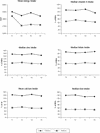Do low-income lone mothers compromise their nutrition to feed their children?
- PMID: 12642423
- PMCID: PMC154913
Do low-income lone mothers compromise their nutrition to feed their children?
Abstract
Background: Women who live in disadvantaged circumstances in Canada exhibit dietary intakes below recommended levels, but their children often do not. One reason for this difference may be that mothers modify their own food intake to spare their children nutritional deprivation. The objective of our study was to document whether or not low-income lone mothers compromise their own diets to feed their children.
Methods: We studied 141 low-income lone mothers with at least 2 children under the age of 14 years who lived in Atlantic Canada. Women were identified through community organizations using a variety of recruitment strategies. The women were asked weekly for 1 month to recall their food intake over the previous 24 hours; they also reported their children's (n = 333) food intake. Mothers also completed a questionnaire about "food insecurity," that is, a lack of access to adequate, nutritious food through socially acceptable means, during each interview.
Results: Household food insecurity was reported by 78% of mothers during the study month. Mothers' dietary intakes and the adequacy of intake were consistently poorer than their children's intake overall and over the course of a month. The difference in adequacy of intake between mothers and children widened from Time 1, when the family had the most money to purchase food, to Time 4, when the family had the least money. The children experienced some improvement in nutritional intake at Time 3, which was possibly related to food purchases for them associated with receipt of the Child Tax Benefit Credit or the Goods and Services Tax Credit.
Interpretation: Our study demonstrates that low-income lone mothers compromise their own nutritional intake in order to preserve the adequacy of their children's diets.
Figures
Comment on
-
Low income, welfare and nutritional vulnerability.CMAJ. 2003 Mar 18;168(6):709-10. CMAJ. 2003. PMID: 12642427 Free PMC article. No abstract available.
References
-
- Campaign 2000. Child poverty in Canada: report card 2000. Toronto: The Campaign; 2000. p. 1-18.
-
- National Council of Welfare. Poverty profile 1998. Ottawa: The Council; 2000.
-
- GPI Atlantic. Income distribution in Nova Scotia. Halifax: GPI Atlantic; 2001. Available: www.gpiatlantic.org/ab_incdist.shtml (accessed 2003 Jan 17).
-
- Chaudhuri N. Child health, poverty and the environment: the Canadian context. Can J Public Health 1998;89(1):S26-30. - PubMed

